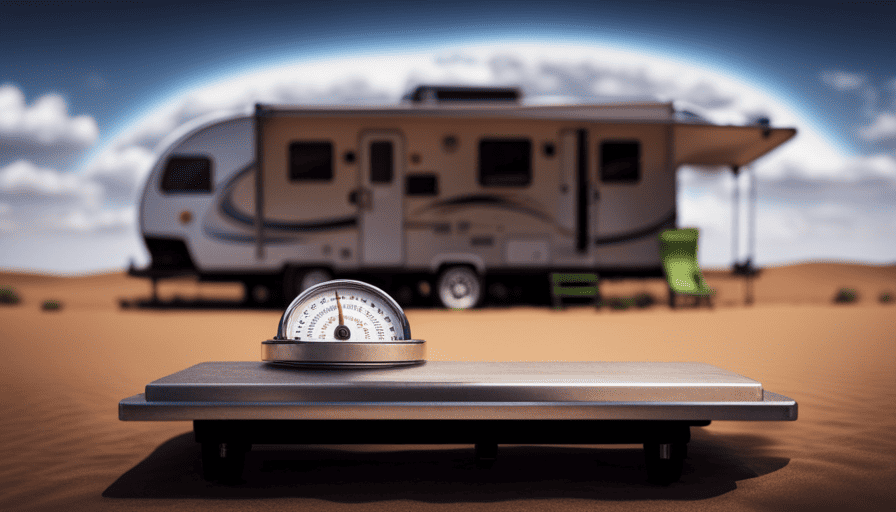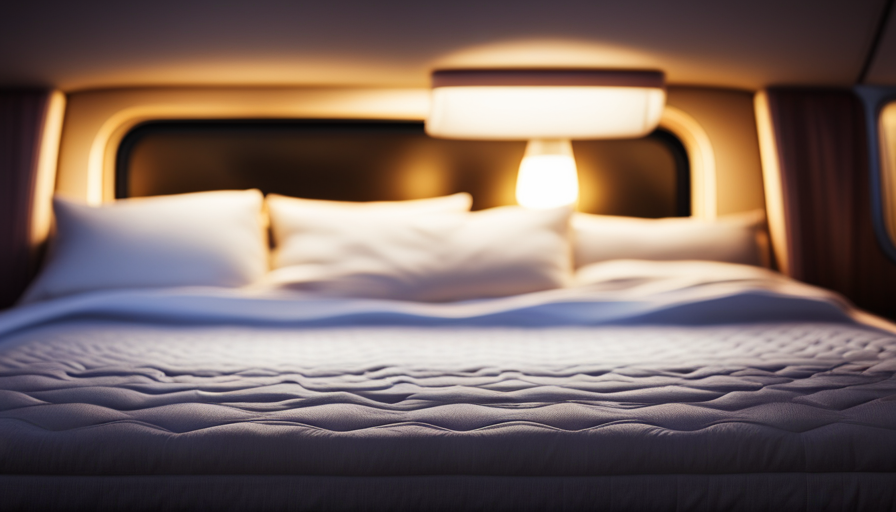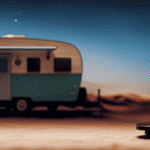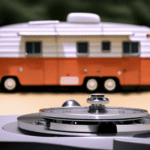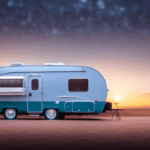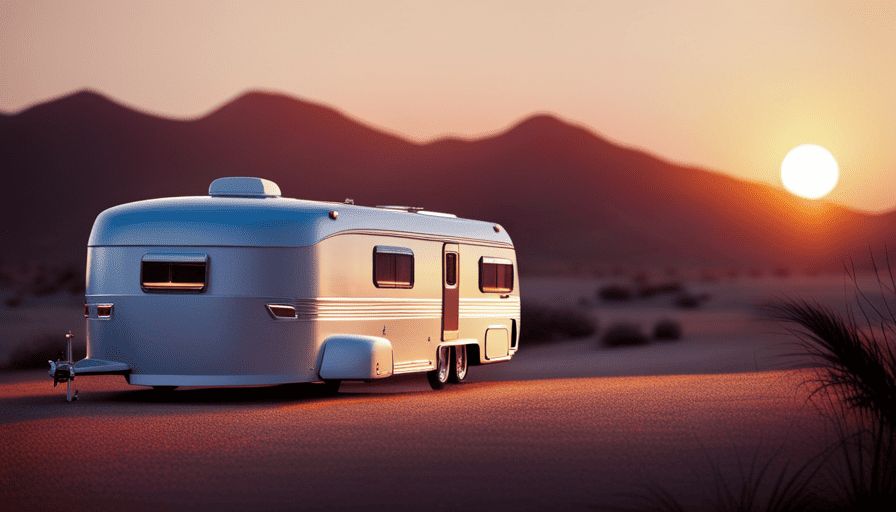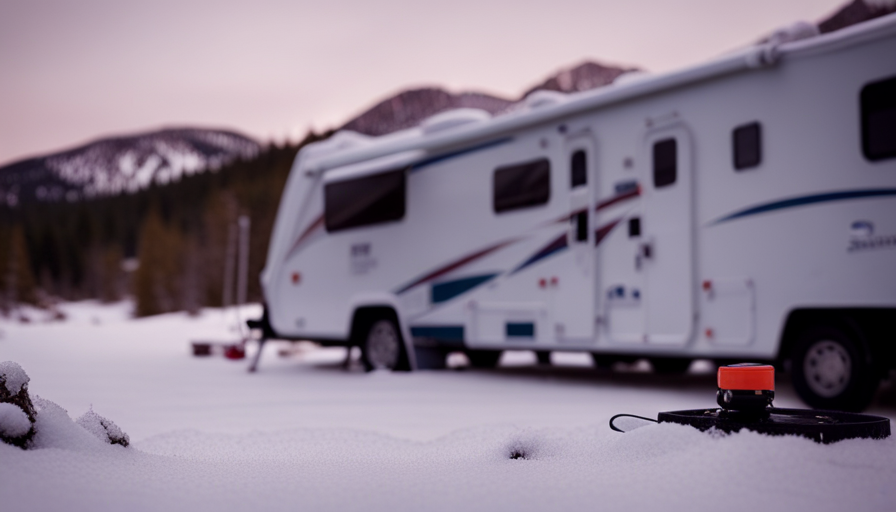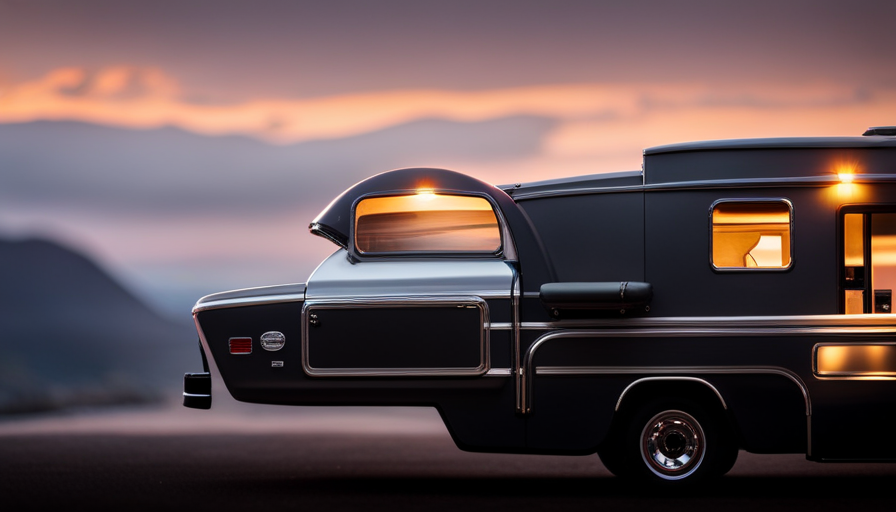Have you ever thought about the weight of a camper? You’re in luck! This article will give you all the necessary information about camper weights. It is important to know the weight of a camper for safe and effective towing or hauling.
When it comes to campers, there are various types available, each with its own weight specifications. From pop-up campers to travel trailers, fifth wheels, and Class C motorhomes, the weight can vary significantly. Factors such as size, construction materials, and additional features can all affect the overall weight of a camper.
If you’re planning to purchase a camper or already own one, it’s essential to know its weight to ensure you have the proper towing or hauling capacity. But how do you determine the weight of a specific camper? Don’t worry, I’ll explain that too!
So, if you’re ready to dive into the world of camper weights and learn how to choose the right camper for your needs and vehicle, let’s get started!
Key Takeaways
- Camper weight is influenced by factors such as size, construction materials, and added features.
- Different types of campers have varying weight specifications.
- Pop-up campers are lighter compared to other types of campers, with an average weight ranging from 800 to 3,000 pounds.
- Class C motorhomes are larger and heavier than Class B campervans, weighing between 10,000 to 12,000 pounds on average.
Understanding Camper Weight Terminology
So, you’re probably wondering how much a camper weighs, right? Well, understanding camper weight terminology is key to fully grasp this concept.
One important aspect to consider is weight distribution. Camper weight needs to be evenly distributed to ensure a safe and smooth ride. This means that heavy items should be placed towards the center and close to the floor, while lighter items can be stored higher up.
Another crucial factor to consider is the importance of camper weight limits. Every camper has a maximum weight capacity that shouldn’t be exceeded. Exceeding this limit can lead to damage to the vehicle, decreased fuel efficiency, and even accidents. It’s essential to know the weight limits of your camper and make sure you don’t overload it. Understanding these weight limits will help you determine how much gear and supplies you can bring along on your camping trips.
Moving on to the next section about factors that affect camper weight, let’s explore how different elements can influence the overall weight of a camper.
Factors That Affect Camper Weight
To get a better idea of the weight of your camper, imagine the impact of factors like size, materials, and added features on its overall heft.
There are several factors that can affect the weight of a camper. One of the main factors is the size of the camper. Generally, larger campers tend to weigh more than smaller ones due to the additional materials needed to construct them.
Another factor is the materials used in the construction of the camper. Campers made with lightweight materials such as aluminum will weigh less than those made with heavier materials like steel.
Additionally, the added features in a camper can also contribute to its weight. Features such as slide-outs, awnings, and appliances can all add to the overall weight.
If you are looking to reduce the weight of your camper, there are a few tips to keep in mind. Consider removing any unnecessary items or equipment that you won’t be using. You can also opt for lightweight materials when making upgrades or renovations. By being mindful of these factors and making smart choices, you can effectively reduce the weight of your camper.
Now, let’s take a look at the average weight of pop-up campers.
Average Weight of Pop-Up Campers
If you’re considering a pop-up camper, you’ll be pleased to know that they typically come in at a lighter weight compared to other types, making them a convenient and manageable option for your outdoor adventures. The weight of a pop-up camper is influenced by various factors, such as its size, construction materials, and features. Here are some key points to consider when it comes to the average weight of pop-up campers:
-
Size: Pop-up campers are available in various sizes, ranging from small units that sleep two people to larger models that can accommodate a family. The weight of the camper will generally increase with its size.
-
Construction Materials: The materials used in the construction of the camper can impact its weight. Lightweight materials, such as aluminum or fiberglass, are commonly used to reduce the overall weight of the camper.
-
Features: The inclusion of additional features, such as kitchenettes, bathrooms, or slide-out sections, can add to the weight of the pop-up camper. It’s important to consider which features are necessary for your camping needs.
-
Pop-Up Camper Weight Limits: Each pop-up camper has a weight limit specified by the manufacturer. It’s crucial to adhere to these weight limits to ensure safe towing and avoid damage to the camper.
Considering these factors, the average weight of a pop-up camper can range from around 800 to 3,000 pounds.
Now, let’s transition to the subsequent section about the average weight of travel trailers.
Average Weight of Travel Trailers
When considering travel trailers, you’ll find that they come in a range of weights depending on their size, construction materials, and features. Travel trailer weight limits are important to understand because exceeding these limits can lead to safety concerns and potential damage to your vehicle.
To calculate the weight of a camper, you’ll need to consider its dry weight, which refers to the weight of the trailer without any additional items or fluids, and the payload capacity, which includes the weight of all your belongings, water, and propane. It’s crucial to stay within the weight limits specified by the manufacturer to ensure safe towing.
To determine the average weight of travel trailers, you’ll find that smaller models can weigh around 2,000 to 5,000 pounds, while larger ones can range from 5,000 to 12,000 pounds or more. As you move into heavier trailers, you may need a heavier-duty tow vehicle.
Transitioning into the subsequent section about the average weight of fifth wheels, it’s important to consider the differences in weight distribution and towing requirements.
Average Weight of Fifth Wheels
Fifth wheels, on average, tend to be heavier than travel trailers and require a stronger tow vehicle. The weight distribution of a fifth wheel is different from that of a travel trailer, as the hitch is mounted in the bed of a pickup truck instead of being attached to the rear bumper. This allows for better weight distribution and stability while towing.
The added features in a fifth wheel, such as multiple slide-outs, larger living spaces, and additional amenities, contribute to its increased weight compared to a travel trailer. These added features provide more comfort and convenience for camping enthusiasts but also increase the overall weight of the camper. It is important to consider the weight of a fifth wheel and ensure that the tow vehicle is capable of safely towing it.
Transitioning to the next section about the average weight of class B campervans, it is interesting to note that these campervans are generally much lighter and more compact compared to both travel trailers and fifth wheels.
Average Weight of Class B Campervans
On average, you’ll find that class B campervans are considerably lighter and more compact compared to both travel trailers and fifth wheels, with an average weight of around 6,000 pounds. Class B campervans offer a convenient and versatile option for travelers who prioritize mobility and maneuverability.
Here are some key features and tips to consider when it comes to class B campervans:
-
Fuel Efficiency: Class B campervans are known for their better fuel consumption compared to larger RVs. Their smaller size and aerodynamic design contribute to improved gas mileage, making them a cost-effective choice for long trips.
-
Compact Layout: Because of their smaller size, class B campervans require efficient use of space. Consider investing in multi-purpose furniture, collapsible items, and storage solutions to maximize the available room. Utilize overhead cabinets, under-bed storage, and wall-mounted organizers to keep your belongings organized and easily accessible.
-
Folding Beds: Many class B campervans feature folding beds, allowing you to convert the seating area into a comfortable sleeping space. This feature is especially handy if you plan on spending nights on the road or in camping areas.
-
Compact Kitchen: Class B campervans often come equipped with a compact kitchenette, including a small refrigerator, stove, and sink. While the space is limited, it provides the essentials for cooking simple meals and enjoying a hot cup of coffee.
-
Outdoor Living: Class B campervans often have an awning or an extendable canopy, providing a shaded outdoor living area. Take advantage of this space for dining, relaxing, or simply enjoying the scenic views.
With their lightweight design, fuel efficiency, and compact layout, class B campervans offer a practical and comfortable option for travelers.
Moving on to the next topic, let’s explore the average weight of class C motorhomes.
Average Weight of Class C Motorhomes
Class C motorhomes, with their spacious interiors and sleek designs, offer a luxurious and comfortable option for travelers seeking a home away from home on the road. These motorhomes are larger and heavier than Class B campervans, providing more living space and amenities.
On average, Class C motorhomes weigh between 10,000 to 12,000 pounds, depending on the specific model and features. When it comes to fuel efficiency, Class C motorhomes typically average around 8 to 10 miles per gallon. However, this can vary depending on factors such as the engine size, weight of the motorhome, and driving conditions. It’s important to consider the additional weight of the motorhome when calculating fuel costs for your trip.
Maintenance costs for Class C motorhomes can also vary. Regular maintenance tasks such as oil changes, tire rotations, and engine tune-ups are necessary to keep the motorhome in good working condition. Additionally, larger motorhomes may require more expensive parts and repairs compared to smaller campervans.
Determining the weight of a specific camper can be done by referring to the manufacturer’s specifications or consulting the vehicle’s documentation. It’s important to know the weight of your camper to ensure you are within the weight limits set by your vehicle and to make informed decisions about towing capacity and overall safety.
How to Determine the Weight of a Specific Camper
To get a sneak peek into the true weight of your specific camper and uncover its hidden secrets, all you need to do is follow these simple steps.
First, locate the manufacturer’s plate, usually found inside a cabinet or on the driver’s side door jamb. This plate will provide you with important information, including the weight of the camper when it left the factory.
Next, gather all your supplies: a bathroom scale, blocks of wood, and a notepad. Position the scale on a flat, level surface and place the blocks of wood on top. Carefully drive one wheel of the camper onto the scale, making sure it’s centered.
Record the weight displayed on the scale and repeat this process for all the other wheels. Add up the weights of all the wheels to calculate the total weight of the camper. Keep in mind that this method provides an estimate and may not account for any modifications or additions made to the camper.
With the calculated weight, you can then determine the weight capacity of your camper and ensure you’re towing or hauling it properly.
Transitioning to the next section about tips for properly towing or hauling a camper, it’s essential to understand the weight of your camper to ensure a safe journey.
Tips for Properly Towing or Hauling a Camper
Get ready to hit the road with confidence by following these essential tips for safely towing or hauling your camper.
-
Proper maintenance: Before embarking on your journey, make sure your vehicle and camper are in good condition. Check the tires, brakes, lights, and hitch to ensure everything’s working properly. Regular maintenance will help prevent any unexpected issues during your trip.
-
Safety precautions: It’s important to take safety precautions to ensure a smooth and safe towing experience. Distribute the weight evenly in your camper, securing all items to prevent shifting while in motion. Use safety chains and double-check that the hitch is properly connected. Adjust your mirrors to provide optimal visibility and consider installing a trailer brake controller for added control.
-
Know your limits: Understand the weight limits of your vehicle and camper. Exceeding these limits can put unnecessary strain on your vehicle and compromise safety. Be mindful of the maximum towing capacity and make sure your vehicle is equipped to handle the weight of your camper.
-
Practice and be patient: Towing a camper can be challenging, especially for beginners. Take some time to practice maneuvering and backing up in a safe, open area. Be patient and give yourself enough time to react to different road conditions.
By following these tips, you can ensure a safe and enjoyable towing experience. In the next section, we’ll discuss choosing the right camper for your needs and vehicle.
Conclusion: Choosing the Right Camper for Your Needs and Vehicle
Make sure you choose the perfect camper that suits your needs and vehicle, allowing you to create unforgettable memories on the road.
When it comes to choosing the right camper size, it’s important to consider the weight capacity of your vehicle. You don’t want to exceed the maximum weight that your vehicle can safely tow or haul.
To determine the weight capacity of your vehicle, you can refer to the owner’s manual or contact the manufacturer. This’ll give you an idea of how much weight your vehicle can handle. It’s crucial to stay within this limit to ensure safe and efficient towing or hauling.
When selecting a camper, you should also consider the weight distribution. Make sure that the weight is properly distributed throughout the camper and that it isn’t too heavy on one side. This’ll help maintain stability and prevent any potential accidents or damage to your vehicle.
Additionally, think about the amenities and features you need in a camper. Consider the number of people who’ll be traveling with you and the amount of storage space you require. Take into account your camping style and preferences as well.
By choosing the right camper size and considering the weight capacity of your vehicle, you can have a smooth and enjoyable camping experience. So, take the time to do your research and make an informed decision. Happy camping!
Frequently Asked Questions
How much does a camper weigh when fully loaded with gear and supplies?
When fully loaded with gear and supplies, a camper’s weight can vary depending on its size and model. However, it’s important to consider weight distribution and its impact on vehicle performance. Properly distributing the weight throughout the camper is crucial for maintaining stability and preventing excessive strain on the vehicle’s suspension system. This ensures a smoother and safer driving experience.
Are there any weight restrictions or limitations for towing a camper?
There are weight limits and towing capacity restrictions that need to be considered when towing a camper. These limitations vary depending on the vehicle and its capabilities.
It’s crucial to consult the vehicle’s manual or contact the manufacturer to determine the specific weight limits and towing capacity. Exceeding these limits can be dangerous and may result in damage to the vehicle or compromise its ability to tow the camper safely.
What are the potential consequences of exceeding the recommended weight limit for a camper?
Exceeding the recommended weight limit for a camper can have serious consequences. It can negatively impact the camper’s handling, making it more difficult to control and increasing the risk of accidents. The additional weight puts strain on the vehicle’s suspension, brakes, and tires, potentially leading to mechanical failures.
To ensure safety, it’s crucial to adhere to weight limits and follow proper safety measures. This includes distributing weight evenly and using weight distribution hitches or sway control devices.
Is there a specific weight range that is considered ideal for most campers?
Weight considerations for campers are important to ensure safe towing and optimal performance. Common camper weights can range from 1,500 to 8,000 pounds, depending on the type and size.
Interestingly, studies show that exceeding the recommended weight limit can lead to reduced fuel efficiency, increased braking distances, and potential damage to the vehicle’s suspension. Therefore, it’s crucial to stay within the specific weight range recommended by the manufacturer for a camper to avoid any potential consequences.
How does the weight of a camper affect fuel efficiency when towing or hauling?
The weight of a camper can have a significant impact on fuel consumption and vehicle performance when towing or hauling. Heavier campers require more energy to move, resulting in increased fuel consumption.
Additionally, the added weight can affect the vehicle’s acceleration, braking, and overall stability, potentially compromising its performance.
Therefore, it’s important to consider the weight of a camper and its impact on fuel efficiency and vehicle performance when making towing or hauling decisions.
What is the Average Weight of a Camper?
The average weight of a camper can vary depending on its size and materials used. For instance, a 24 ft camper weight can range from 4,000 to 7,000 pounds. These weights include the essential components of the camper, such as appliances, furniture, and water tanks. It’s important to consider these weights when towing or transporting a camper to ensure safe travel.
Conclusion
In conclusion, choosing the right camper for your needs and vehicle is crucial for a successful camping experience.
One interesting statistic to note is that the average weight of a pop-up camper is around 1,000 to 2,000 pounds, making it a lightweight and easily towable option.
However, it’s important to consider factors such as the weight of travel trailers, fifth wheels, and class C motorhomes, which can range from 3,000 to 20,000 pounds.
By understanding camper weight terminology and following proper towing or hauling tips, you can ensure a safe and enjoyable camping adventure.

